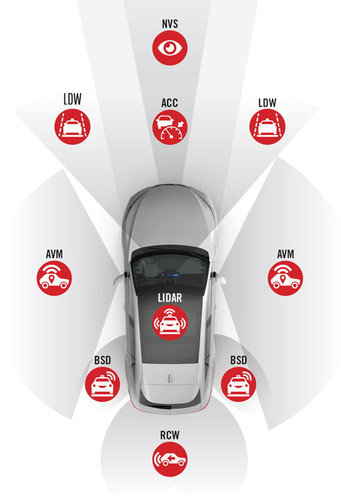In the world of ADAS calibrations, there are numerous abbreviations that might leave you scratching your head. This blog post aims to demystify these abbreviations and provide a comprehensive guide to understanding ADAS (Advanced Driver Assistance Systems) calibrations.

- LDW - Lane Departure Warning:
- Definition: LDW systems alert the driver when the vehicle drifts out of its lane without using a turn signal.
- Significance: Calibration ensures that the LDW system accurately detects lane markings and issues timely warnings.
- Sensors Involved: Cameras
- FCW – Front Collision Warning:
- Definition: System tht detects vehicles or obstacles in the vehicle's path and warns the driver of an impending collision.
- Significance: Similar to Automatic Emergency Braking, this sends an alert to the driver that a forward-facing collision is imminent
- Sensors Involved: Forward-facing radar system
- AEB - Automatic Emergency Braking:
- Definition: AEB systems automatically apply the brakes to prevent or mitigate collisions with other vehicles or obstacles.
- Significance: Calibration ensures the system recognizes obstacles and reacts appropriately, avoiding false alarms or missed warnings.
- Sensors Involved: Forward-facing radar system
- ACC - Adaptive Cruise Control:
- Definition: ACC maintains a safe following distance from the vehicle in front by adjusting the vehicle's speed.
- Significance: Calibration ensures the ACC system accurately measures distances and controls the vehicle's speed in response to traffic conditions.
- Sensors Involved: Forward-facing radar and / or camera
- LKA - Lane Keeping Assist:
- Definition: LKA helps keep the vehicle within its lane by applying steering inputs.
- Significance: Calibration ensures that the LKA system responds appropriately to road markings and keeps the vehicle within the designated lane.
- Sensors Involved: Forward-facing radar and camera
- BSM - Blind Spot Monitoring:
- Definition: Blind Spot Monitoring is an ADAS feature that uses sensors and cameras to detect vehicles in the driver's blind spots, typically highlighting the presence of an object with a notice on the side-mirrors..
- Significance: Calibration is crucial to ensure that BSM accurately detects vehicles in adjacent lanes and provides timely warnings, helping the driver avoid potential blind spot-related collisions when changing lanes or otherwise.
- Sensors Involved: Side- and rear-facing radar
- AVM - All View Monitoring:
- Definition: All View Monitoring, also known as Surround View or 360-degree camera system, provides a comprehensive view of the area around the vehicle by combining images from multiple cameras.
- Significance: Calibration ensures that AVM accurately stitches together images from all cameras, offering a clear and coherent view of the vehicle's surroundings, assisting with parking and maneuvering in tight spaces.
- Sensors Involved: Multiple cameras around the vehicle
- RCW - Rear Collision Warnings:
- Definition: Rear Collision Warnings are ADAS features that detect vehicles approaching from behind and provide warnings to the driver to prevent rear-end collisions, especially when backing out of a parking spot.
- Significance: Calibration is necessary for accurate detection of vehicles approaching from the rear and issuing timely warnings to avoid potential collisions, enhancing overall rear-end collision prevention.
- Sensors Involved: Rear-facing radar
Understanding ADAS calibration abbreviations is essential for maintaining the safety and functionality of these advanced systems in your vehicle. By adhering to OEM specifications and ensuring precise calibration, you can enjoy the benefits of these innovative technologies while staying safe on the road. Whether it's LDW, AEB, ACC, or any other ADAS component, proper calibration is the key to their successful operation. At ADAS Depot, we try to remove as much of the tech jargon as possible, so that you can successfully calibrate vehicles.
If you liked this content, please subscribe to our newsletter for more great posts.

